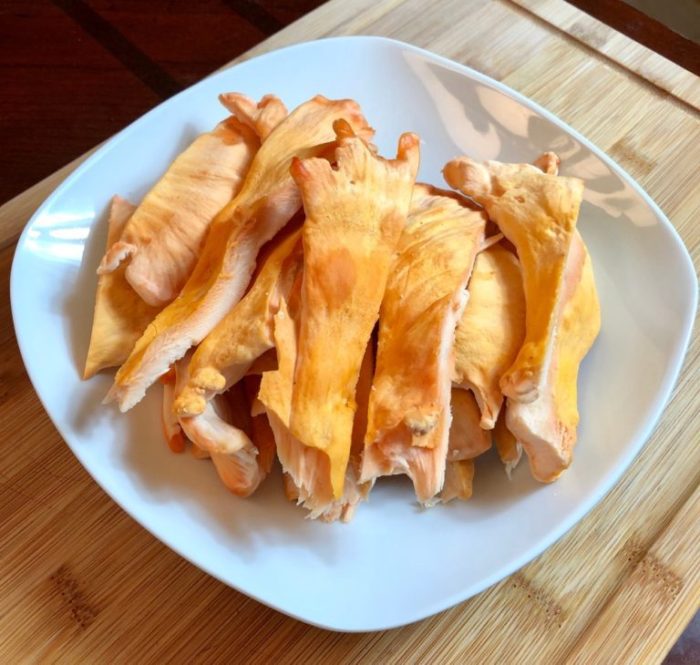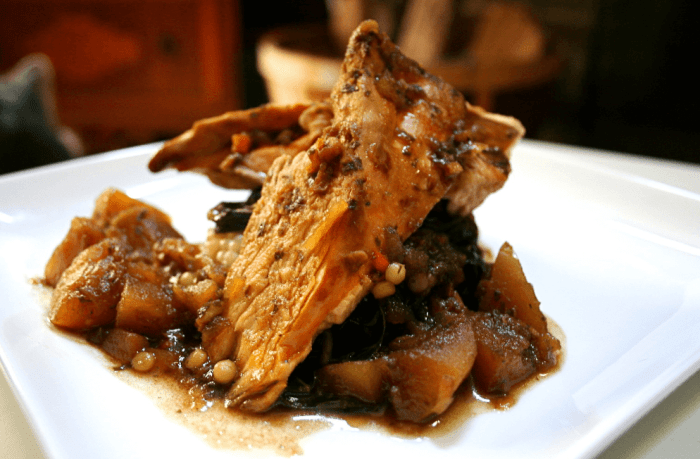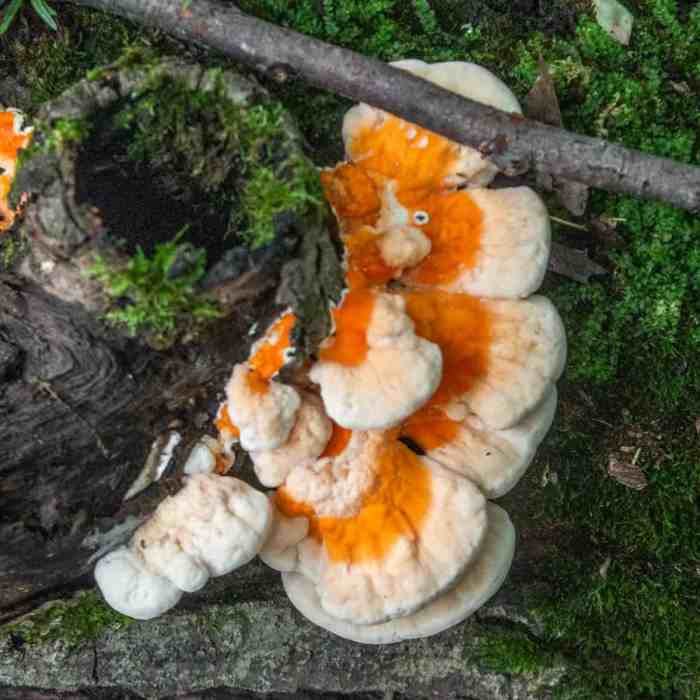
Chicken of the woods recipe – Unveiling the secrets of the Chicken of the Woods, this culinary journey takes you into the heart of the forest, exploring its unique flavors and textures. From sautéing to grilling, this guide unveils the versatility of this woodland treasure, inspiring you to create mouthwatering dishes that will tantalize your taste buds.
As we delve into the world of Chicken of the Woods, we’ll discover its nutritional value, learn how to identify and harvest it sustainably, and explore the art of preserving its freshness. Get ready to embark on a culinary adventure that will transform your meals into unforgettable feasts.
Overview of Chicken of the Woods

Chicken of the Woods (Laetiporus sulphureus) is a large, edible mushroom that grows in clusters on the trunks of oak trees. It is characterized by its bright orange-yellow color, its chicken-like texture, and its mild, slightly fruity flavor.
Chicken of the Woods is found throughout North America and Europe, and it is typically harvested in the fall. It is a popular mushroom among foragers and mushroom enthusiasts, and it is often used in soups, stews, and other dishes.
Nutritional Value and Potential Health Benefits
Chicken of the Woods is a good source of dietary fiber, protein, and vitamins. It also contains several antioxidants, which may have a number of health benefits.
- Dietary fiber:Chicken of the Woods is a good source of dietary fiber, which is important for digestive health. Fiber helps to regulate bowel movements, and it can also help to lower cholesterol levels and reduce the risk of heart disease.
- Protein:Chicken of the Woods is a good source of protein, which is essential for building and repairing tissues. Protein also helps to keep you feeling full and satisfied.
- Vitamins:Chicken of the Woods contains several vitamins, including vitamin C, vitamin D, and vitamin B3. Vitamin C is important for immune function, vitamin D is important for bone health, and vitamin B3 is important for energy metabolism.
- Antioxidants:Chicken of the Woods contains several antioxidants, which can help to protect cells from damage. Antioxidants have been linked to a number of health benefits, including reduced risk of heart disease, cancer, and Alzheimer’s disease.
Culinary Applications of Chicken of the Woods

Chicken of the woods is a versatile mushroom with a meaty texture and a slightly nutty flavor. It can be prepared in a variety of ways, including sautéing, roasting, grilling, and frying.
One of the most popular ways to cook chicken of the woods is to sauté it. To do this, simply heat some oil in a skillet over medium heat and add the mushrooms. Cook until they are browned on all sides and tender.
Soups and Stews, Chicken of the woods recipe
Chicken of the woods can also be used to make soups and stews. The mushrooms add a rich flavor and a meaty texture to these dishes. To make a chicken of the woods soup, simply add the mushrooms to your favorite soup base and simmer until they are cooked through.
Have you heard about the delectable chicken of the woods recipe ? This culinary masterpiece offers a unique twist on the traditional chicken dish, using the vibrant and flavorful chicken of the woods mushroom.
Pasta Dishes
Chicken of the woods can also be used in pasta dishes. The mushrooms can be added to a variety of pasta sauces, including tomato sauce, Alfredo sauce, and pesto. To make a chicken of the woods pasta dish, simply cook the pasta according to package directions and add the mushrooms to the sauce.
Flavor and Texture of Chicken of the Woods

Chicken of the Woods is known for its unique flavor and texture that sets it apart from other mushrooms. It has a meaty, chicken-like texture that makes it a popular substitute for poultry in vegetarian and vegan dishes.
When raw, Chicken of the Woods has a firm texture that becomes tender and juicy when cooked. It has a slightly sweet and nutty flavor with a hint of umami, making it a versatile ingredient that can be used in a variety of dishes.
Cooking Methods and Their Effects
Different cooking methods can affect the flavor and texture of Chicken of the Woods. Here’s a brief overview:
- Sautéing:Sautéing Chicken of the Woods in a pan with a little oil enhances its savory flavor and creates a crispy exterior.
- Roasting:Roasting Chicken of the Woods in the oven intensifies its sweetness and gives it a tender, almost steak-like texture.
- Grilling:Grilling Chicken of the Woods over an open flame imparts a smoky flavor and a slightly charred exterior.
- Frying:Frying Chicken of the Woods in a deep fryer or pan creates a crispy coating and a tender, juicy interior.
Identifying and Harvesting Chicken of the Woods: Chicken Of The Woods Recipe

Identifying Chicken of the Woods is relatively straightforward. It typically forms large, shelf-like structures on the sides of trees or logs. The upper surface of the mushroom is brightly colored, ranging from orange to yellow, while the underside is white or cream-colored.
If you’re curious about exploring this culinary adventure, check out the chicken of the woods recipe . This easy-to-follow guide will walk you through the steps of preparing this delicious and nutritious dish. Bon appétit!
The flesh is white and firm, with a meaty texture.
The best time to harvest Chicken of the Woods is in the late summer and fall. It can be found in deciduous forests, particularly on oak trees. When harvesting, it is important to cut the mushroom cleanly from the tree or log.
It is also important to practice sustainable harvesting practices, such as only taking what you need and leaving the rest for others to enjoy.
Identifying Characteristics
- Large, shelf-like structures
- Brightly colored upper surface (orange to yellow)
- White or cream-colored underside
- White, firm flesh with a meaty texture
Best Time and Location for Harvesting
- Late summer and fall
- Deciduous forests, particularly on oak trees
Sustainable Harvesting Practices
- Cut the mushroom cleanly from the tree or log
- Only take what you need
- Leave the rest for others to enjoy
Storing and Preserving Chicken of the Woods

Chicken of the woods is a highly perishable mushroom and should be stored and preserved properly to maintain its quality and prevent spoilage.
Refrigeration
Fresh chicken of the woods can be stored in the refrigerator for up to 5 days. To refrigerate, clean the mushrooms thoroughly to remove any dirt or debris. Cut off any bruised or damaged parts. Wrap the mushrooms loosely in a paper towel or place them in a perforated plastic bag.
Store them in the refrigerator’s crisper drawer, where they will stay cool and humid.
Freezing
Freezing is an excellent method for preserving chicken of the woods for longer periods. Clean the mushrooms and cut them into smaller pieces. Blanch the mushrooms in boiling water for 2-3 minutes, then drain and cool them. Place the blanched mushrooms in freezer-safe bags or containers.
Freeze the mushrooms for up to 6 months.
Drying
Drying is another effective way to preserve chicken of the woods. Clean the mushrooms and slice them thinly. Arrange the slices on a drying rack or baking sheet lined with parchment paper. Place the mushrooms in a warm, dry, and well-ventilated area.
Allow them to dry for several days until they are completely brittle. Store the dried mushrooms in an airtight container in a cool, dry place.
Canning
Canning is a safe and reliable method for preserving chicken of the woods. Clean the mushrooms and cut them into bite-sized pieces. Combine the mushrooms with a brine solution made with water, salt, and vinegar. Bring the brine to a boil, then pour it over the mushrooms in sterilized jars.
Seal the jars and process them in a boiling water bath for the recommended time.
Pickling
Pickling is a delicious way to preserve chicken of the woods. Clean the mushrooms and cut them into small pieces. Combine the mushrooms with a pickling solution made with vinegar, water, sugar, and spices. Bring the pickling solution to a boil, then pour it over the mushrooms in sterilized jars.
Seal the jars and store them in a cool, dark place.
Tips for Extending Shelf Life
* Handle the mushrooms carefully to avoid bruising or damaging them.
- Store the mushrooms in a cool, humid environment to prevent drying out.
- Avoid storing the mushrooms in plastic bags, as this can trap moisture and promote spoilage.
- If the mushrooms start to show signs of spoilage, such as discoloration or sliminess, discard them immediately.
Wrap-Up
Our exploration of Chicken of the Woods has revealed a culinary gem, offering a unique blend of flavors and textures that elevate any dish. Whether you’re a seasoned forager or a curious cook, this guide has equipped you with the knowledge and inspiration to make the most of this woodland delicacy.
So, venture into the forest, embrace the bounty of nature, and let the Chicken of the Woods ignite your culinary creativity.
Key Questions Answered
How can I identify Chicken of the Woods?
Chicken of the Woods is characterized by its bright orange color, shelf-like shape, and velvety texture. It typically grows on dead or dying oak trees.
What are the health benefits of Chicken of the Woods?
Chicken of the Woods is a good source of protein, fiber, and antioxidants. It may also have anti-inflammatory and anti-cancer properties.
How should I store Chicken of the Woods?
Fresh Chicken of the Woods can be stored in the refrigerator for up to a week. It can also be dried, canned, or pickled for longer storage.